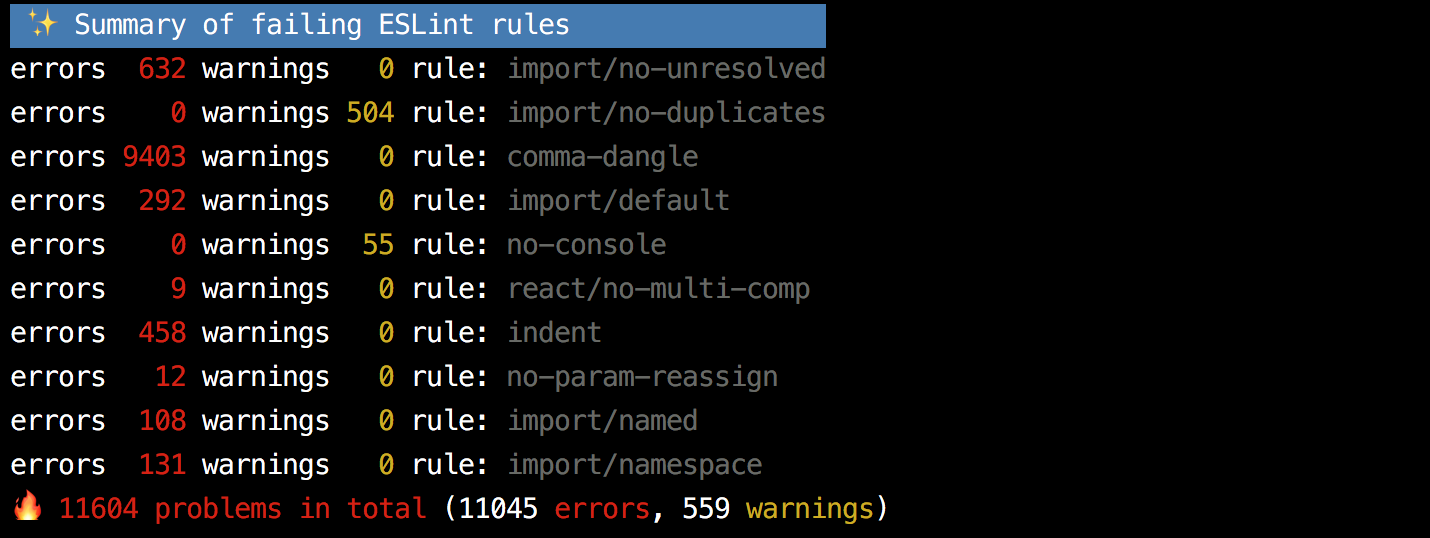@voxpelli/eslint-formatter-summary
ESLint formatter aggregating results by rule
Fork of mhipszki/eslint-formatter-summary pending the upstreaming of some/all changes.
Features
- aggregated errors / warnings per rule
- sort by rule name, number of errors or warnings
- NEW: output markdown
TL;DR
This formatter simply aggregates the ESLint results by rule and shows the following output:
It can also be configured to sort results by rule, errors or warnings using env vars e.g.
EFS_SORT_BY=rule EFS_SORT_DESC=true eslint -f @voxpelli/eslint-formatter-summary ./src(see details below).
How to install
npm i -D @voxpelli/eslint-formatter-summaryHow to use
When you run ESLint just specify @voxpelli/eslint-formatter-summary as the formatter:
eslint -f @voxpelli/eslint-formatter-summary [file|dir|glob]*See http://eslint.org/docs/user-guide/command-line-interface#-f---format
Intention
It is a matter of minutes to add ESLint to a new project, however it can be quite challenging to introduce it (or just add a stricter rule set) to existing projects, already large codebases.
Possibly hundreds if not thousands of errors will pop up which can seem overwhelming to be fixed when we see the default formatted output, forcing us to back up from making our code base better / more consistent.
This package provides a custom ESLint formatter to help in these situations to make the right decisions by showing the linting results aggregated by rule. It gives an overview of all rules failing showing the total number of errors and warnings summed up by rule.
Having this summary overview can give us the opportunity e.g. to consider suppressing certain rules for now and bringing them back in later when we are ready to fix them.
Output format
With the default ESLint formatter you might get several thousands of lines of failing rules in various files in the output e.g.:
The Summary Formatter simply aggregates the ESLint results by rule and shows the following output instead:
In the above example we can notice that the comma-dangle rule is responsible for about 2/3 of the failures, so we can consider turning it off or just suppressing it to a warning for now as we can do so with the other failing rules.
Sorting output
Default sorting is by
errorsin adescendingorder
Configuration options can be passed to the formatter to alter the output.
Using theEFS_SORT_BY env var the aggregated results can be sorted by either rule, errors or warnings e.g.
EFS_SORT_BY=rule eslint -f @voxpelli/eslint-formatter-summary ./srcsorted string results are shown in ASCENDING order by default and numbers in DESCENDING order, but the order can be reversed using EFS_SORT_REVERSE=true:
EFS_SORT_BY=rule EFS_SORT_REVERSE=true eslint -f @voxpelli/eslint-formatter-summary ./srcChanging output format
To output the summary as a markdown table, set EFS_OUTPUT=markdown
EFS_OUTPUT=markdown eslint -f @voxpelli/eslint-formatter-summary ./srcExample:
| Errors | Warnings | Rule |
|---|---|---|
| 1 | 0 | no-const-assign
|
| 1 | 0 | no-undef
|
| 1 | 0 | no-unused-vars
|
Supported Node versions
This project targets the current LTS releases of Node.js. See engines.node in package.json.
Supported ESLint versions
ESLint versions are supported from v8 onwards.
Contribute
Please feel free to submit an issue describing your proposal you would like to discuss. PRs are also welcome!
Run unit tests
npm test
Test build project
Once the project is built the distribution version can be tested via passing a .js file to npm run try.
For example:
npm run try test.js
CI build
The project is built on GitHub Actions targeting each supported Node.js versions (see the list above).
During the CI build all source files are linted and all unit tests need to pass resulting in a coverage report.
License
MIT



